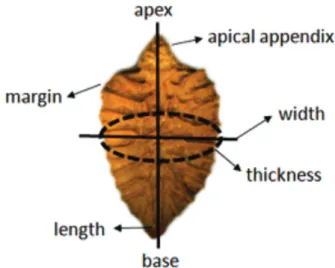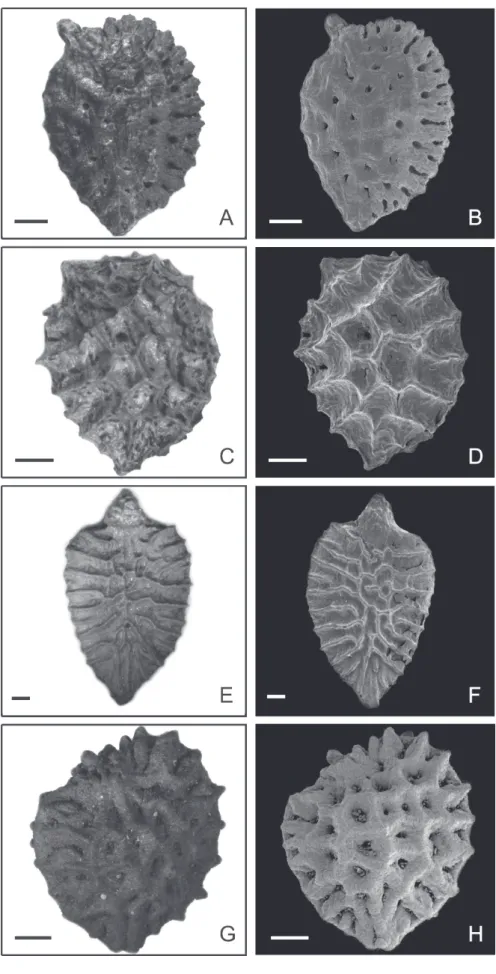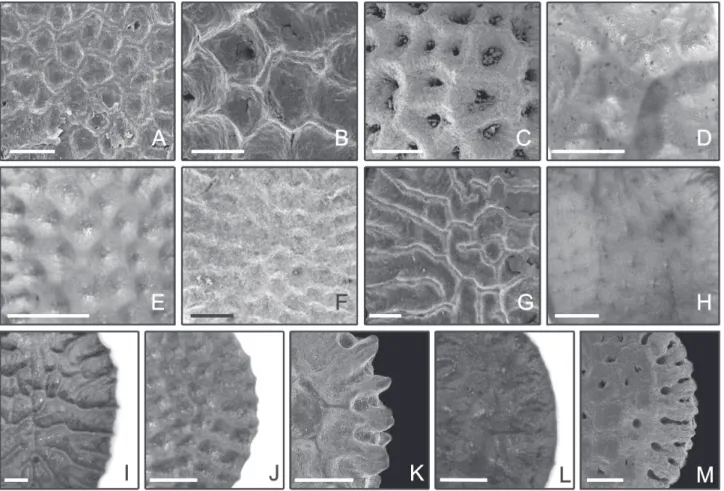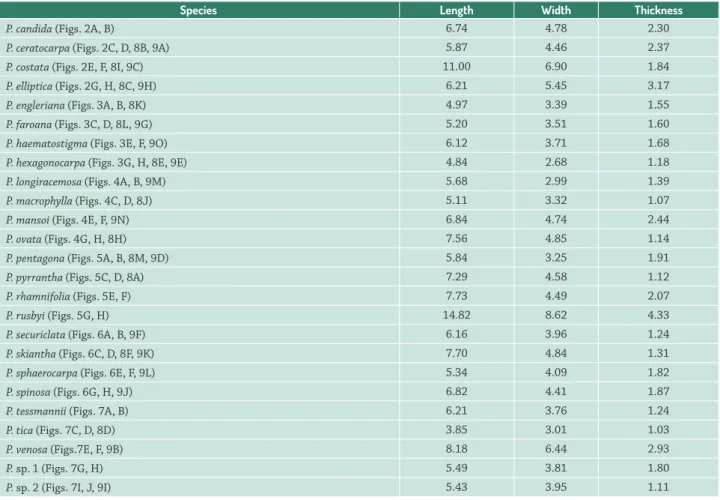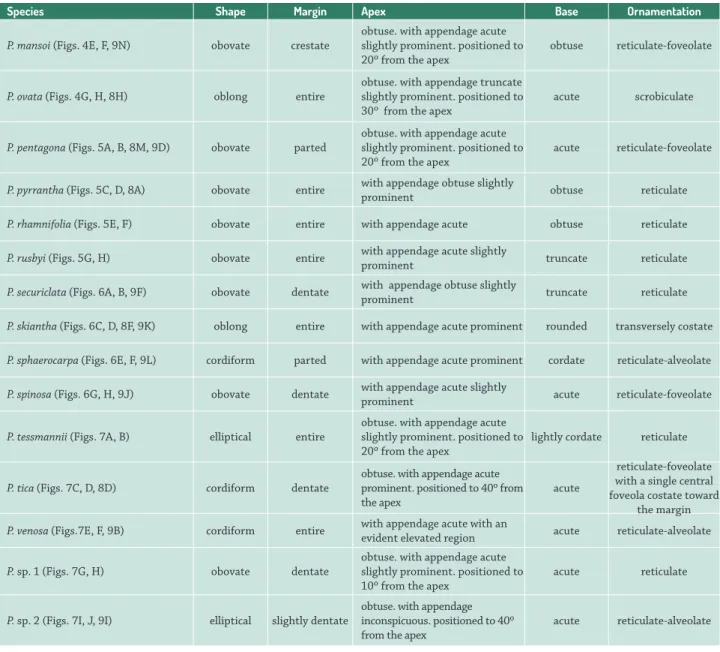.
doi: 10.1590/0102-33062016abb0414
The taxonomic signifi cance of seed morphology in the
Passifl ora
subgenus
Astrophea
(Passifl oraceae)
Ana Carolina Mezzonato-Pires1*, Cláudia Barbieri Ferreira Mendonça1, Michaele Alvim Milward-De-Azevedo2 and Vania Gonçalves-Esteves1
Received: November 25, 2016 Accepted: January 23, 2017
ABSTRACT
Th e center of diversity for Passifl ora subg. Astrophea is in low altitude areas of northern South America. Th e majority of species of this group are diffi cult to fi nd in nature. Seed morphology was described in detail for 25 species of Passifl ora subgenus Astrophea, a subgenus that until now did not exist. For morphological analysis, 20 seeds per species were measured for length, width and thickness, and the arithmetic means calculated. Th e seeds varied in length, width and thickness. Eight types of ornamentation were found. Th e margins varied among crestate, dentate, parted, entire and parted-crestate. Th e seed apex can be distinguished by the shape and position of the apical appendage. Seed shape varied among obovate, lanceolate, cordiform, and oblong to elliptical. An identifi cation key was developed and a PCA was performed both using the principal morphological characters. Morphological characters of seeds are a new source of data for delimiting taxa with quite confl icting morphological boundaries, such as seen here with the Passifl ora subgenus Astrophea. Furthermore, seed morphology is especially useful for the identifi cation of specimens with only fruits and, consequently, seeds available.
Keywords: Astrophea, fruits, morphological characters, seeds, systematics
Introduction
Passifl ora subgenus Astrophea is one of fi ve subgenera belonging to the genus Passifl ora. It is comprised of about 60 species distributed in South and Central America, with only two species in the latter, Passifl ora pittieri and Passifl ora tica (Escobar 1994). Th e major center of diversity for Passifl ora subg. Astrophea is in areas of low altitude in northern South America (Ulmer & MacDougal 2004). In Brazil, the subgenus is represented by approximately 25 species (BFG 2015) with the greatest concentration being in the north. According to Ulmer & MacDougal (2004), species of Passifl ora subg. Astrophea are similar to typical Passifl ora but with unique morphological
characteristics, and so are considered the most unusual of the genus. In addition to having a climbing habit, this subgenus also exhibits shrub or tree habits, and has tiny stipules, entire leaf blades, two glands on the petiole, tiny bracts, and campanulate lily fl owers with a yellow corona or red tubular fl owers with a reddish corona. Th e majority of species of this group are rare and diffi cult to fi nd in nature. Species identifi cation of specimens in the absence of fl owers is usually impossible since most of the diagnostic characters are in the fl owers, and so when specimens are only fruits, seeds can serve as a valuable identifi cation tool.
Th e importance of describing seeds extends beyond taxonomy and systematics to archaeology, paleobotany and even to farming and gardening by helping identify
1 Departamento de Botânica, Museu Nacional, Universidade Federal do Rio de Janeiro, Quinta da Boa Vista, São Cristovão, 20940-040, Rio de Janeiro, RJ, Brazil
2 Departamento de Ciências do Meio Ambiente, Instituto Três Rios, Universidade Federal Rural do Rio de Janeiro, Av. Prefeito Alberto da Silva Lavinas 1847, 25802-100, Três Rios, RJ, Brazil
* Corresponding author: carolina.mezzonato@gmail.com
The taxonomic significance of seed morphology in the Passiflora subgenus Astrophea (Passifloraceae)
cultured species (Johri 1984). According to Haridasan & Mukherjee (1988), environmental conditions have little infl uence on the characteristics of the seed surface, and thus these characters should better refl ect the underlying genetics and be more useful in analyses of phylogenetic relationships. In a morphological study of the seeds of 51 species of the genus Passifl ora, Pérez-Cortéz et al. (2002) demonstrated the existence of great diversity. Ulmer & MacDougal (2004) claim that the size and, especially, the surface of seeds are often useful characters for taxonomy. As an understudied subgenus with poorly known and defi ned species, pollen studies of Passifl ora subg. Astrophea were conducted with the hope of fi nding characters useful in species delimitations. Th e species of Passifl ora subg. Astrophea analyzed (Mezzonato-Pires et al. 2015) revealed various important characters.
Th us, the present study aims to describe the seed morphology of 25 species of the Passifl ora subg. Astrophea in order to identify characters with taxonomic potential that can assist in classifi cation and be used in future phylogenetic analyses.
Materials and methods
The seeds of 25 species of the Passiflora subgenus Astrophea (DC.) Mast. were studied (S1 in supplementary material). Th e material used was taken from exsicates deposited in herbaria whose acronyms are in accordance with the Index Herbariorum (Th iers, continuously updated): IAN, INPA, MG, MO, NYBG, R, RB and UB.
For morphological analysis, 20 seeds per species (when possible) were measured for length, width and thickness (Fig. 1), and the arithmetic means calculated. Description of the base, apex, margin and ornamentation used the terminology of Perez-Cortez et al. (2002) with some modifi cations. Th e classifi cation of seeds followed Perez-Cortez et al. (2002), except that the most ornamented region of the margin was considered, and the apex was more fully described. Th e measurements were performed using a digital caliper. Th e aryl was removed and the seeds were digitally photographed using a Leica M205C stereomicroscope with an attached DFC295 digital camera. Selected seeds were fi xed to double-sided carbon tape and then metalized with a thin layer of palladium gold (ca. 150° thickness) for three minutes and analyzed with a Jeol Model JSM 6390 scanning electron microscope of the Departamento de Invertebrados do Museu Nacional, Universidade Federal do Rio de Janeiro.
Th e principal component analysis (PCA) was performed on 42 variables (power = 0.5, square root transformed) using the software PC-ORD 5.0 (McCune & Meff ord 2006). Th e variance-covariance matrix and biplot of distance were selected. Th e results are presented in a two-dimensional graph of the fi rst and second principal components.
An identifi cation key was developed using the principal morphological characters of the seeds.
Results
Th e seeds examined in this study are illustrated in Figures 2-9 and their measurements and morphological characters are presented, in Tables 1 and 2, respectively. Th e species analyzed were: Passifl ora candida, Passifl ora ceratocarpa, Passifl ora costata, Passifl ora elliptica, Passifl ora engleriana, Passifl ora faroana, Passifl ora haematostigma, Passifl ora hexagonocarpa, Passifl ora longiracemosa, Passifl ora macrophylla, Passifl ora mansoi, Passifl ora ovata, Passifl ora pentagona, Passifl ora pyrrhantha, Passifl ora rhamnifolia, Passifl ora rusbyi, Passifl ora securiclata, Passifl ora skiantha, Passiflora sphaerocarpa, Passiflora spinosa, Passiflora tessmannii, Passifl ora tica, Passifl ora venosa, Passifl ora sp. 1 and Passifl ora sp. 2.
Th e seeds varied in length (3.85-14.82 mm), width (2.68-8.62 mm) and thickness (1.03-4.33 mm) (Tab. 1). Th e species Passifl ora rusbyi stood out as having the longest (14.82 mm), widest (8.62 mm) and thickest (4.33 mm) seeds. Passifl ora tica had the shortest (3.85 mm) and thinnest seeds, while Passifl ora hexagonocarpa, had the narrowest (2.68 mm) (Tab. 1).
Eight types of ornamentation were found: reticulate (Fig. 8A), coarsely reticulate (Fig. 8B), reticulate-foveolate (Fig. 8C), reticulate-foveolate with a single central foveola costate toward the margin (Fig. 8D), reticulate-alveolate (Fig. 8E) (with homogeneous or heterogeneous alveola), transversely costate (Fig. 8F), transversely costate toward the margin (fi g. 8G) and scrobiculate (Fig. 8H). Th e margins varied among crestate (Fig. 8I), dentate (Fig. 8J), parted (Fig. 8K), entire and parted-crestate (Fig. 8M).
Th e seed apex can be distinguished by the shape and position of the apical appendage (Tab. 2). Some species have the apical appendage positioned exactly on the apex of the seed, such as: P. costata, P. faroana, P. haematostigma, P. pyrrhantha, P. rhamnifolia, P. rusbyi, P. securiclata, P. skiantha,
Ana Carolina Mezzonato-Pires, Cláudia Barbieri Ferreira Mendonça, Michaele Alvim Milward-De-Azevedo and Vania Gonçalves-Esteves
The taxonomic significance of seed morphology in the Passiflora subgenus Astrophea (Passifloraceae)
Ana Carolina Mezzonato-Pires, Cláudia Barbieri Ferreira Mendonça, Michaele Alvim Milward-De-Azevedo and Vania Gonçalves-Esteves
The taxonomic significance of seed morphology in the Passiflora subgenus Astrophea (Passifloraceae)
Ana Carolina Mezzonato-Pires, Cláudia Barbieri Ferreira Mendonça, Michaele Alvim Milward-De-Azevedo and Vania Gonçalves-Esteves
The taxonomic significance of seed morphology in the Passiflora subgenus Astrophea (Passifloraceae)
Figure 7. Photomicrographs and electron photomicrographs of seeds of the species of Passiflora subgenus Astrophea. A-B. P. tessmannii.
Ana Carolina Mezzonato-Pires, Cláudia Barbieri Ferreira Mendonça, Michaele Alvim Milward-De-Azevedo and Vania Gonçalves-Esteves
P. sphaerocarpa, P. spinosa and P. venosa. The appendage of other species are positioned 10º to 40º from the apex and their shapes vary among: acute (Fig. 9A), acute with an evident elevated region (Fig. 9B), acute prominent (Fig. 9C), acute slightly prominent (Fig. 9D), acute-truncate (Fig. 9E), obtuse slightly prominent (Fig. 9F), truncated slightly prominent (Fig. 9G), fused (Fig. 9H) and inconspicuous (Fig. 9I) (Tab. 2). The seeds of the majority of species have an acute base (Fig. 9J), but others are rounded (Fig. 9K), cordate (Fig. 9L), truncate (Fig. 9M), obtuse (Fig. 9N) and truncate to slightly acute (Fig. 9O).
The shape of the analyzed seeds (Tab. 2) varied among obovate, lanceolate, cordiform, and oblong to elliptical. The predominant shape in the majority of species was obovate, with the variation of narrowly obovate in only two species. Considering only seed characters, it is apparent that there is great morphological variety within the Passiflora subg. Astrophea. The characteristics that varied most were surface ornamentation, shape of the apical appendage and size and condition of the margin. Thus, the description of
seeds is very useful in the delimitation of species of this group, thereby assisting in the identification of specimens with only fruit.
All of the quantitateive and qualitative characters were used in a PCA. The results of the PCA explained 32.64 % of the accumulative variance (Tab. 3). The first principal component explained 19.52 % of the total variance, with the most significant characters being those of appendage displacement and the shape of the obtuse apex. Only species with seeds with a displaced appendage occurred on the positive side of Axis 1, whereas species with the appendage on the apex were on the negative side. Species with an obtuse seed apex were also grouped on the positive side of Axis 1. The second principal component explained 13.11 % of the total variance, with the most significant character being the shape of the acute prominent appendage. All reticulate species were positioned on the negative side of Axis 2. The third principal component explained 9.71 % of the total variance, mainly through the character of obovate seed shape.
Figure 8. Photomicrographs and electron photomicrographs of ornamentation and margin of the seeds of the species of Passiflora
The taxonomic significance of seed morphology in the Passiflora subgenus Astrophea (Passifloraceae)
Table 1.Measurements (in mm) of the seeds of the species of Passiflora subgenus Astrophea.
Species Length Width Thickness
P. candida (Figs. 2A, B) 6.74 4.78 2.30
P. ceratocarpa (Figs. 2C, D, 8B, 9A) 5.87 4.46 2.37
P. costata (Figs. 2E, F, 8I, 9C) 11.00 6.90 1.84
P. elliptica (Figs. 2G, H, 8C, 9H) 6.21 5.45 3.17
P. engleriana (Figs. 3A, B, 8K) 4.97 3.39 1.55
P. faroana (Figs. 3C, D, 8L, 9G) 5.20 3.51 1.60
P. haematostigma (Figs. 3E, F, 9O) 6.12 3.71 1.68
P. hexagonocarpa (Figs. 3G, H, 8E, 9E) 4.84 2.68 1.18
P. longiracemosa (Figs. 4A, B, 9M) 5.68 2.99 1.39
P. macrophylla (Figs. 4C, D, 8J) 5.11 3.32 1.07
P. mansoi (Figs. 4E, F, 9N) 6.84 4.74 2.44
P. ovata (Figs. 4G, H, 8H) 7.56 4.85 1.14
P. pentagona (Figs. 5A, B, 8M, 9D) 5.84 3.25 1.91
P. pyrrantha (Figs. 5C, D, 8A) 7.29 4.58 1.12
P. rhamnifolia (Figs. 5E, F) 7.73 4.49 2.07
P. rusbyi (Figs. 5G, H) 14.82 8.62 4.33
P. securiclata (Figs. 6A, B, 9F) 6.16 3.96 1.24
P. skiantha (Figs. 6C, D, 8F, 9K) 7.70 4.84 1.31
P. sphaerocarpa (Figs. 6E, F, 9L) 5.34 4.09 1.82
P. spinosa (Figs. 6G, H, 9J) 6.82 4.41 1.87
P. tessmannii (Figs. 7A, B) 6.21 3.76 1.24
P. tica (Figs. 7C, D, 8D) 3.85 3.01 1.03
P. venosa (Figs.7E, F, 9B) 8.18 6.44 2.93
P. sp.1(Figs. 7G, H) 5.49 3.81 1.80
P. sp.2 (Figs. 7I, J, 9I) 5.43 3.95 1.11
Table 2. Morphological characterization of seeds of species of Passiflora subgenus Astrophea
Species Shape Margin Apex Base Ornamentation
P. candida (Figs. 2A, B) obovate parted-crestate
obtuse. with appendage acute prominent. positioned to 40º from the apex
acute reticulate-foveolate
P. ceratocarpa (Figs. 2C, D, 8B, 9A) obovate crestate truncate. with appendage acute.
positioned to 30º from the apex acute coarsely reticulate
P. costata (Figs. 2E, F, 8I, 9C) lanceolate crestate with appendage acute prominent acute transversely costate
toward the margin
P. elliptica (Figs. 2G, H, 8C, 9H) cordiform crestate acute. with appendage fused cordate reticulate-foveolate
P. engleriana (Figs. 3A, B, 8K) obovate parted
obtuse. with appendage acute prominent, positioned o 20º from the apex
truncate transversely costate toward the margin
P. faroana (Figs. 3C, D, 8L, 9G) oblong entire with appendage truncate slightly
prominent obtuse reticulate
P. haematostigma (Figs. 3E, F, 9O) obovate dentate wth appendage acute slightly
prominent
truncate to
slightly acute reticulate
P. hexagonocarpa (Figs. 3G, H, 8E, 9E) narrowly
obovate parted-crestate
acute. with appendage acute-truncate positioned to 30º from the apex
truncate reticulate-alveolate. alveola homogeneous
P. longiracemosa (Figs. 4A, B, 9M) narrowly
obovate parted-crestate
obtuse. with appendage acute slightly prominent. positioned to 20º from the apex
truncate reticulate-alveolate. alveola heterogeneous
P. macrophylla (Figs. 4C, D, 8J) obovate dentate
obtuse. with appendage acute slightly prominent. positioned to 20º from the apex
Ana Carolina Mezzonato-Pires, Cláudia Barbieri Ferreira Mendonça, Michaele Alvim Milward-De-Azevedo and Vania Gonçalves-Esteves
Species Shape Margin Apex Base Ornamentation
P. mansoi (Figs. 4E, F, 9N) obovate crestate
obtuse. with appendage acute slightly prominent. positioned to 20º from the apex
obtuse reticulate-foveolate
P. ovata (Figs. 4G, H, 8H) oblong entire
obtuse. with appendage truncate slightly prominent. positioned to 30º from the apex
acute scrobiculate
P. pentagona (Figs. 5A, B, 8M, 9D) obovate parted
obtuse. with appendage acute slightly prominent. positioned to 20º from the apex
acute reticulate-foveolate
P. pyrrantha (Figs. 5C, D, 8A) obovate entire with appendage obtuse slightly
prominent obtuse reticulate
P. rhamnifolia (Figs. 5E, F) obovate entire with appendage acute obtuse reticulate
P. rusbyi (Figs. 5G, H) obovate entire with appendage acute slightly
prominent truncate reticulate
P. securiclata (Figs. 6A, B, 9F) obovate dentate with appendage obtuse slightly
prominent truncate reticulate
P. skiantha (Figs. 6C, D, 8F, 9K) oblong entire with appendage acute prominent rounded transversely costate
P. sphaerocarpa (Figs. 6E, F, 9L) cordiform parted with appendage acute prominent cordate reticulate-alveolate
P. spinosa (Figs. 6G, H, 9J) obovate dentate with appendage acute slightly
prominent acute reticulate-foveolate
P. tessmannii (Figs. 7A, B) elliptical entire
obtuse. with appendage acute slightly prominent. positioned to 20º from the apex
lightly cordate reticulate
P. tica (Figs. 7C, D, 8D) cordiform dentate
obtuse. with appendage acute prominent. positioned to 40º from the apex
acute
reticulate-foveolate with a single central foveola costate toward
the margin
P. venosa (Figs.7E, F, 9B) cordiform entire with appendage acute with an
evident elevated region acute reticulate-alveolate
P. sp.1(Figs. 7G, H) obovate dentate
obtuse. with appendage acute slightly prominent. positioned to 10º from the apex
acute reticulate
P. sp.2 (Figs. 7I, J, 9I) elliptical slightly dentate
obtuse. with appendage inconspicuous. positioned to 40º from the apex
acute reticulate-alveolate
Table 2. Cont.
Table 3. Cumulative variance and vectores values of principal component analysis (PCA) using palinological characters of 25 táxons of Passiflora subgenus Astrophea.
Axis of the principal component 1 2 3
Cumulative variance (%) 32.647 19.528 13.119
Characters Axis
Length -0.226 0.0156 0.1798
Width -0.1561 0.0816 0.2012
Thickness -0.0581 0.0447 0.1843
Shape obovate -0.0153 -0.4270 0.3568
Shape narrowly obovate 0.0818 0.0448 -0.2482
Shape lanceolate -0.0303 0.0803 0.0977
Shape cordiform 0.0133 0.2701 0.0208
Shape oblong -0.0970 0.0911 -0.1282
Shape elliptical 0.0476 -0.0593 -0.0990
Margin crestate 0.0445 0.1460 0.2725
Margin dentate 0.0785 -0.2670 0.0798
The taxonomic significance of seed morphology in the Passiflora subgenus Astrophea (Passifloraceae)
Table 3. Cont.
Axis of the principal component 1 2 3
Cumulative variance (%) 32.647 19.528 13.119
Characters Axis
Margin entire -0.3153 0.0134 -0.1933
Margin parted-crestate 0.1250 0.0364 -0.1965
Apppendage on the apex -0.4695 0.0340 0.0873
Apppendage displaced 0.4695 -0.0340 -0.0873
Shape of apex obtuse 0.3928 -0.1881 -0.0674
Shape of apex truncate 0.0226 0.0408 0.0934
Shape of apex acute 0.0541 0.1133 -0.1133
Shape of appendage acute -0.0184 -0.0462 0.0476
Shape of appendage acute prominent 0.0066 0.3254 0.1507
Shape of appendage acute slightly prominent 0.1082 -0.3766 0.0687
Shape of appendage acute with an evident elevated region -0.0387 0.0730 0.0096
Shape of appendage acute-truncate 0.0335 0.0444 -0.1376
Shape of appendage obtuse slightly prominent -0.1018 -0.0894 -0.0333
Shape of appendage truncate slightly prominent -0.0448 0.0277 -0.1055
Shape of appendage fused 0.0206 0.0689 0.0243
Shape of appendage inconspicuous 0.0347 -0.0273 -0.0243
Base acute 0.1861 0.1313 0.3784
Base cordate 0.0149 0.1247 -0.0700
Base truncate 0.0115 -0.0299 -0.2470
Base obtuse -0.1291 -0.2215 -0.0554
Base truncate to slightly acute -0.0312 -0.0680 0.0167
Base rounded -0.0522 0.0634 -0.0227
Reticulate -0.2500 -0.3921 -0.1891
Coarsely reticulate 0.0226 0.0408 0.0934
Reticulate-foveolate 0.1375 -0.0455 0.2883
Reticulate-foveolate with a single central foveola costate
toward the margin 0.0499 0.0404 0.0065
Reticulate-alveolate 0.0727 0.1692 -0.2361
Transversely costate -0.522 0.0634 -0.0227
Transversely costate toward the margin 0.0049 0.0930 0.0930
Scrobiculate 0.0146 0.0309 -0.0333
In the two-dimensional graph of the PCA (Fig. 10), it can be seen that the species P. pentagona, P. tica and P. longiracemosa have the highest values on the first principal component and P. sphaerocarpa, P. costata and P. venosa, on
the second. Passiflora rusbyi, P. pyrrhantha and P. rhamnifolia have the lowest values on the first principal component and P. macrophylla, P. haematostigma and P. securiclata on the second.
Key based on seed characters for species identification of the
Passiflora
subg.
Astrophea
1. Seeds with surface transversely costate
2. Shape lanceolate, margin crestate (Figs. 2E, F, 8I, 9C) …... P. costata 2’. Shape obovate, oblong, margin parted or entire
3. Appendage in the seed apex, rounded base (Figs. 6C, D, 8F, 9K) ... P. skiantha 3’. Appendage positioned 20° from the seed apex, truncate base (Figs. 3A, B, 8K) ………...…….. P. engleriana 1’. Seeds with surface no transversely costate
4. Surface scrobiculate (Figs. 4G, H, 8H) ... P. ovata 4’. Surface reticulate, coarsely reticulate, reticulate-foveolate, reticulate-foveolate with a single central foveola costate toward the margin or reticulate-alveolate
5. Seed base cordate to slightly cordate
6. Shape elliptical (Figs. 7A, B) ... P. tessmannii 6’. Shape cordiform
Ana Carolina Mezzonato-Pires, Cláudia Barbieri Ferreira Mendonça, Michaele Alvim Milward-De-Azevedo and Vania Gonçalves-Esteves
7’. Surface reticulate-foveolate, apex acute with fused appendage (Figs. 2G, H, 8C, 9H) ...P. elliptica 5’. Seed base acute, truncate or obtuse
8. Margin entire
9. Appendage truncate (Figs. 3C, D, 8L, 9G) ... P. faroana 9’. Appendage no truncate
10. Shape cordiforme (Figs.7E, F, 9B) ... P. venosa 10’. Shape obovate, narrowly obovate or elliptical
11. Base truncate (Figs. 5G, H) ... P. rusbyi 11’. Base obtuse
12. Appendage acute (Figs. 5E, F) ... P. rhamnifolia 12’. Appendage obtuse (Figs. 5C, D, 8A) ... P. pyrrhantha 8’. Margin crestate, parted-crestate, parted or dentate
13. Surface reticulate or coarsely reticulate
14. Margin crestate (Figs. 2C, D, 8B, 9A) ... P. ceratocarpa 14’. Margin dentate
15. Shape elliptical (Figs. 7I, J, 9I) ... P. sp. 2 15’. Shape obovate
16. Base obtuse, appendage displaced (Figs. 4C, D, 8J) ... P. macrophylla 16’. Base truncate to slightly acute, appendage at the apex
17. Appendage acute (Figs. 3E, F, 9O).P. haematostigma
17’. Appendage obtuse (Figs. 6A, B, 9F) ... P. securiclata 13’. Surface reticulate-foveolate or reticulate-alveolate
18. Base truncate, shape narrowly obovate
19. Appendage acute-truncate, alveola homogeneous (Figs. 3G, H, 8E, 9E) ... P. hexagonocarpa 19’. Appendage acute slightly prominent, alveola heterogeneous (Figs. 4A, B, 9M) …... P. longiracemosa 18’. Base acute or obtuse, shape obovate or cordiform
20. Appendage acute prominent
21. Shape cordiform, dimensions 3,85x30,1x1,03mm (Figs. 7C, D, 8D) ...…….. P. tica 21’. Shape obovate, dimensions 6,74x4,78x2,30mm (Figs. 2A, B) ...…... P. candida 20’. Appendage acute slightly prominent
22. Margin dentate
23. Surface reticulate-foveolate (Figs. 6G, H, 9J) ... P. spinosa 23’. Surface reticulate-alveolate (Figs. 7G, H ... P. sp. 1 22’. Margin partite or crestate
24. Base obtuse, dimensions 6,84x4,74x2,44 mm (Figs. 4E, F, 9N) ... P. mansoi 24’. Base acute, dimensions 5,84x3,25x1,91 mm (Figs. 5A, B, 8M, 9D) ... P. pentagona
Discussion
Among the species of the Passiflora subgenus Astrophea described by Killip (1938), the seeds were briefly described for seven: P. ceratocarpa, P. elliptica, P. faroana, P. hexagonocarpa, P. longiracemosa, P. pentagona and P. skiantha. The results presented by Killip (1938) were corroborated here for the species P. ceratocarpa with regard to seed shape, while for P. skiantha and P. pentagona, the shape described here was oblong and obovate, respectively. Passiflora elliptica was described by Killip (1938) as widely ovate and coarsely reticulate while the present study found it to be cordiform and reticulate-foveolate. For the species P. faroana, P. hexagonocarpa and P. longiracemosa, the results found here differ from those of Killip (1938) with regard to seed ornamentation. These differences seems to be due to an error in species identifications since the ornamentation is clearly reticulate or reticulate-alveolate.
The taxonomic significance of seed morphology in the Passiflora subgenus Astrophea (Passifloraceae)
Figure 9. Photomicrographs and electron photomicrographs of apical appendage and base of the seeds of the species of Passiflora
subgenus Astrophea. Apical appendage: A. acute (P. ceratocarpa). B. acute with an evident elevated region (P. venosa). C. acute prominent (P. costata). D. acute slightly prominent (P. pentagona). E. acute-truncate (P. hexagonocarpa). F. obtuse slightly prominent (P. securiclata). G. truncate slightly prominent (P. faroana). H. fused (P. elliptica). I. inconspicuous (P. sp. 2). Base: J. acute (P. spinosa). K. rounded (P. skiantha). L. cordate (P. sphaerocarpa). M. truncate (P. longiracemosa). N. obtuse (P. mansoi). O. truncated to slightly acute (P. haematostigma). Bar: 1mm
environments. The seed of P. mansoi was described by this same author as elliptical and with an entire margin; only the obtuse base and reticulate-alveolate ornamentation are corroborated by our results. The shape of the seed of P. spinosa was described as elliptical, and the margin crestate and the ornamentation reticulate-alveolate, thus, only the acute base was consistent with our findings. The apex was described in a different manner in our study, which we think is more detailed and understandable than that by Pérez-Cortéz et al. (2002), who described the seeds of these three species as simply with a “single horn”. These differences may be explained by the fact that P. spinosa is part of a taxonomic complex, and the variation seen in the seeds may be because the material analyzed by these authors may not have been P. spinosa, but another species of the complex.
Pérez-Cortéz et al. (2005; 2009) studied the anatomy of the seed cover for a total of 15 species of the Passiflora subgenus Passiflora. Eight species were analyzed in 2005 and seven in 2009, but only in the 2009 publication did
they describe the type of surface ornamentation, including reticulate, reticulate-foveolate and scrobiculate. These types of surface ornamentation were also found in the seeds of the P. subg. Astrophea, thereby demonstrating a degree of similarity between the two subgenera.
Ana Carolina Mezzonato-Pires, Cláudia Barbieri Ferreira Mendonça, Michaele Alvim Milward-De-Azevedo and Vania Gonçalves-Esteves
Figure 10. Principal component analysis performed with the seeds variables from Passiflora subgenus Astrophea. Species names are abbreviated with the first three letters of the epithet. The colors represent the sections of subgenus Astrophea. blue. section Astrophea; yellow. section Capreolata; green. section Pseudoastrophea; red. section Botryastrophea. Abrreviations:can. candida; cer. ceratocarpa; cos. costata; ell. elliptica; eng. engleriana; far. faroana; hae. haematostigma; hex. hexagonocarpa; lon. longiracemosa; mac. macrophylla; man. mansoi; ova. ovata; pen. pentagona; pyr. pyrrhantha; rha. rhamnifolia; rus. rusbyi; sec. securiclata; ski. skiantha; sph. sphaerocarpa; spi. spinosa; tes. tessmannii; tic. tica; ven. venosa. Please see the PDF version for color reference.
Passiflora subgenus Passiflora was studied by Cervi (1997) and among the 50 species treated, 36 had their seeds described, and most of those had their shape, size (length and width) and surface ornamentation mentioned. The shape of the seeds of this group presented greater variation than the subgenera Astrophea and Decaloba: obcordate, suborbiculate, “cordate”, “cordate”-oblong, ovate, obovate and oblong-obcordate. The seeds were smaller than for the Passiflora subg. Astrophea and most species had foveolate and non-reticulate ornamentation, like most species of this work.
The PCA analysis revealed an evident delimitation of the taxa of the Passiflora subgenus Astrophea pointing to important characters for their separation, such as the location of the appendage on the apex or displaced from the apex. Species that have often been difficult to delimit because of very tenuous characters, such as P. rhamnifolia and P. pentagona, were positioned individually on the graph, showing the separation of these species. Furthermore, the poorly known and collected species P. elliptica, of which there are few fertile specimens, has often been confused with P. rhamnifolia and P. pentagona, however, the PCA analysis demonstrates that it is spatially distanced from
them, thereby confirming its identity.
The taxonomic significance of seed morphology in the Passiflora subgenus Astrophea (Passifloraceae)
Conclusion
Morphological characters of seeds are a new tool for delimiting taxa with quite conflicting morphological boundaries, as seen here with the Passiflora subgenus Astrophea and especially for the identification of specimens with only fruits and, consequently, seeds. In addition to the great taxonomic importance of this work, it will likely provide valuable contributions studies of phylogeny, archaeology, paleobotany, agriculture and horticulture as well.
Acknowledgements
The authors express their gratitude to curators of the herbaria that were visited and those that sent us material for this study and Amanda Soares who helped with the photomicrographs. The first author extends her thanks to the National Council for Scientific and Technological Development (CNPq) for the Doctoral Grant, and also to Research Support Foundation of Rio de Janeiro State (FAPERJ, APQ1- E-26/111.214/2014) for financial resource provided.
References
BFG. 2015. Growing knowledge: an overview of seed plant diversity in Brazil. Rodriguésia 66: 1085-1113.
Cervi AC. 1997. Passifloraceae do Brasil. Estudo do gênero Passiflora L. subgênero Passiflora. Fontqueria 45: 1-92.
E s c o b a r L K . 1 9 9 4 . T w o n e w s p e c i e s a n d a k e w t o the Passiflora subgenus Astrophea. American Society of Plant Taxonomies. Systematic Botany 19: 203-210.
Feuillet C, MacDougal J. 2003. A new infrageneric classification of Passiflora
L. (Passifloraceae). Passiflora: The journal & Newsletter of Passiflora Society International 13: 34-38.
Haridasan VK, Mukherjee PK.1988. Seed surface features of some members of the Indian Campanulaceae. Phytomorphology 37: 277-285. Johri BM.1984. Embryology of Angiosperms. Berlin, Springer Verlag,. Killip EP. 1938. The American species of Passifloraceae. Publication Field
Museum of Natural History, Botanical Series19: 1-613.
Mccune B, Mefford MJ. 2006. PC-ORD, version 5.0, Multivariate analysis of ecological data. Glaneden Beach, MjM Solfware Desing. Mezzonato-Pires AC, Milward-de-Azevedo MA, Mendonça CBF,
Gonçalves-Esteves V. 2015. Pollen morphology and detailed sexine of Passiflora L. subgenus Astrophea (DC.) Masters (Passifloraceae). Plant Systematic and Evolution 301: 2189-2202.
Milward-de-Azevedo MA, Baumgratz JFA, Gonçalves-Esteves V. 2012. A taxonomic revision of Passiflora subgenus Decaloba (Passifloraceae) in Brazil. Phytotaxa 53: 1-68.
Peréz-Cortéz S, Tillett S, Escala M. 2002. Estudio morfológico de la semilla de 51 especies del género Passiflora L. Acta Botanica Venezuelica 25: 67-96.
Peréz-Cortéz S, Escala M, Tillett S. 2005. Anatomía de la cubierta seminal en ocho especies del gênero Passiflora L., subgénero Passiflora. Acta Botanica Venezuelica 28: 337-348.
Peréz-Cortéz S, Escala M, Tillett S. 2009. Morfoanatomia de la cubierta seminal en siete especies de Passiflora L., subgénero Passiflora
(Passifloraceae). Hoehnea 36: 131-137.
Thiers B. [continuously updated]. Index Herbariorum: a global directory of public herbaria and associated staff. New York Botanical Garden’s Virtual Herbarium. http://sweetgum.nybg.org/ih/ 15 Feb.16. Ulmer T, MacDougal JM. 2004. Passiflora: Passionflowersof the world.
